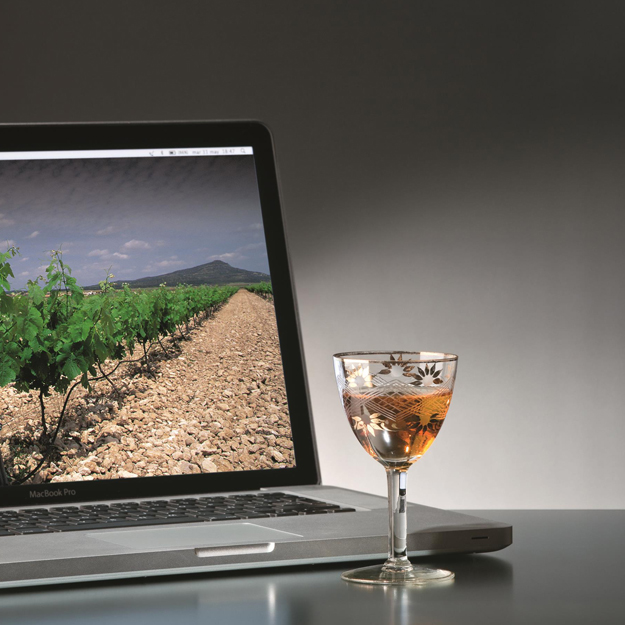.png.transform/rendition-xs/image_image%20(1).png)
Spanish Dessert Wines: Old and New
All countries with a great winemaking tradition boast a few historic dessert wines, some of which have a mythical resonance. Spain is no exception and the tremendous transformation of the Spanish wine world over the last 25 years has included a low-key but truly exciting revolution on the sweet front.

Spain’s dessert wines have a glorious history: the “mountain wines” from Málaga, the Alicante wine that brightened the final days of Louis XIV (1638-1715), the sherries and Canary Sack extolled by Shakespeare (1564-1616), the Malvasía wine from Sitges and so on … Most of these wines, probably fortified with grape spirit so that they could withstand sea travel were traded throughout Europe between the 16th and 18th c. Today interest is steadily increasing with growers reappraising and renewing the traditional styles to meet present consumer preferences.
Sweet means more
In ancient times, sweet wines were considered the most noble. They were more intense, more flavorsome, and they traveled and lasted well. In fact, deliberate dehydration of the grapes was the first formula used by man to concentrate not only the sugars, but all the elements inside the grapes.
Later on, it was discovered that a similar effect could be achieved by cold temperatures (ice wine) or by the Botrytis cinerea fungus. But these two variables are primarily associated with cold climates, whereas Spain is sunny and grapes often become overripe. Excellent grapes for dessert wines such as Moscatel and Malvasía grow well here, and production techniques and raisin wines have a history dating back to the Phoenician presence around 1100 BC.
Concentrated sugars
The most extreme example of a raisin wine is probably PX from the Pedro Ximénez grape grown in various Andalusian DOs (southern Spain). It concerns a sweet wine fortified with pure grape spirit to set off yeasts. The secret behind it is the abundant sunshine, the laborious pressing to extract the “soul” from the raisins and the solera aging system. The oldest soleras at Alvear, Pérez Barquero and Toro Albalá (Montilla-Moriles), the trasañejo made by Bodegas Málaga Virgen and the greatest PX from Jerez (Gran Orden by Garvey, Viejo Rare by Osborne, Venerable by Domecq, Noé by González Byass and others). They are expensive, rare jewels deserving a place amongst the world’s great dessert wines.
Málaga, sweetest of all
DO Malaga is the sole designation in Spain that exclusively makes dessert wines. The hundred-year-old Bodegas Málaga Virgen combine high-production wines such as Málaga Virgen, a blend of up to four types of sweet wine, with two excellent trasañejos (blends of wines aged for about 30 years using the solera system) and modern, naturally sweet Moscatels in which all the sugar and alcohol come from the grapes, like their fragrant Tres Leones.
Naturally sweet wine has made a definite comeback. There have been two main protagonists in this story. The first is Telmo Rodríguez. This widely acclaimed wine-expert is recovering the old mountain wines from the Axarquía district. His Molino Real of naturally sun-dried grapes immediately became an icon among the new Spanish dessert wines. A limited edition of only the best vintages combines the characteristic Moscatel sweetness with delicate, fresh, primary aromas and herbal touches. Moreover it develops well in the bottle.
The second is the US Spanish wine importer, Jorge Ordóñez, who has Malaga blood in his veins. In a personal project and with the expertise of the Austrian Kracher family, he produces four labels with increasing levels of concentration: Special Selection, Victoria (served at the Nobel Prize Awards in 2012), Viejas Viñas and the original Esencia, a unique product not unlike the Hungarian Tokaji, with over half a kilo (1.1 lb) of residual sugar and an alcohol content of barely 4º.

The other Spanish Moscatels
But the pioneer of modern, naturally sweet wines in Spain was a Navarre Moscatel by Bodegas Ochoa. It represents the new generation of Moscatels and has greatly contributed to restore the almost extinct late harvested small-grain Moscatel grape based on careful selection from old vineyards. The result is a clean, fragrant, fresh and fruity wine. This style has gained many followers and, although production is very limited, it is now considered one of the outstanding categories of Navarre wines.
At Chivite they went a step further by introducing barrels. Their Chivite Colección 125 Vendimia Tardía, certainly among Spain’s best, is made from overripe Moscatel grapes harvested in very small batches from mid-October to early December. This is a complex, very concentrated dessert wine with good acidity and developing exceptionally well in the bottle.
Alicante (southeast Spain), the other main area for Spanish Moscatel, has undergone its own revolution. The most outstanding wines come from the La Marina region, close to the sea, where Moscatel de Alejandría has always flourished. The leading pioneer, Bodegas Gutiérrez de la Vega has reaped huge success in the US with its opera-inspired range that goes from the fresh steel fermented Casta Diva Furtiva Lágrima through their star wine Casta Diva Cosecha Miel (combining raisins and very ripe grapes, fermented in steel tanks and aged for 12 months in French oak), to their Casta Diva La Diva, a naturally sweet wine made from sun-dried grapes and aged in wood.
At Bodegas Enrique Mendoza in Alfaz del Pi, they produce two Moscatels for which fermentation is halted with alcohol, avoiding oxidation. Their Moscatel de la Marina is made from grapes harvested at a potential baumé of 12.5º and offers a newfound varietal freshness. The more complex Moscatel de Mendoza from more mature grapes, is macerated with the skins and barrel aged.
Monastrell and Fondillón
The Alicante sweet wine of greatest fame, however, is Fondillón. It is made from overripe Monastrell grapes that almost turn to raisins on the plant. It is a naturally sweet wine, aged a minimum 10 years, either static or by the solera-system. Bodegas Gutiérrez de la Vega has brought out two small-scale, artisan versions aged for 10 and 15 years and fermented in open barrels.
The Mendoza family adopts a freer approach with its Dolç de Mendoza, a modern Monastrell wine. This too is made from grapes that dry on the plant. After aging in French oak for 3-4 years, the end result is both dense and fruity.
The former Mistela wines made from Monastrell have given way to sweet reds that retain more of the grape’s character. At Bodega Olivares in Jumilla (Murcia), grapes of old, ungrafted vines, are left to become overripe on the plant until even early November. It is bottled in June and stored for two years before being sold.
Bodegas Castaño in Yecla (Murcia) make a sweet red Monastrell, successfully being exported to Europe, the United States and Asia. Predominant in this Murcia Monastrell are flavors of very ripe, black grapes, figs and the balsamic touches of Mediterranean scrub.
More Mediterranean sweet wines

In Catalonia (northeast Spain), it is Garnacha (both red and white) along with Moscatel that serve to produce the traditional dessert wines like Mistela, as well as vino rancio (aged oxidatively in glass demijohns), and naturally sweet wines.
With the exception of some sweet rancio wines such as those from Priorat, generally the must of fully ripe grapes is fortified with alcohol. This means that most of Catalonia’s sweet wines are classified as liqueur wines. The main bastion here is the century-old firm De Muller in Reus, which makes up to 300,000 bottles of dessert wine a year and exports widely. One of its jewels is the limited edition Pajarete Augusto Solera 1851, rated RB95.
Modernization in Catalonia has come either with technology (Gramona produces ice wines made by cryoextraction), by updating traditional styles (e.g. Josefina Piñol Dulce Blanco, rated RB 95, of surprising fruitiness and vivacity) or by personal selection in the vineyard. An emblematic example is Dolç de l’Obac by Bodegas Pastrana, made of overripe Garnacha grapes allowing alcohol, acidity and sugar all to come from the grape.
The Malvasía route, endpoint the Canary Islands
The other great variety with a natural vocation for dessert wines is Malvasía. Lanzarote (Canary Islands) is considered home to the largest Malvasía growing area in Europe today. Grapes are air-dried, often off the plant to retain aromas. The style ranges from young, fruity wines like El Grifo to others that are aged using the solera system, like those from the Bermejos winery which are reminiscent of the “Canary” wines, so highly coveted in the 16th and 17th c.
Sitges, a beauty spot on the Tarragona coast, is better known today as a tourist attraction than as the home of the once-famous Malvasía. The wine has survived thanks to diplomat Manuel Llopis who bequeathed his Aiguadolç vineyard to the Sant Joan Baptista Hospital in Sitges on the condition that it continued to produce sweet Malvasía. And they do so most successfully!
In Majorca, the Malvasía de Banyalbufar cooperative returned to this variety and has brought out a light, aromatic and medium-sweet wine. In northwest Spain, we find the first late-harvest txakoli wines. A few years ago, the Ribeiro cooperative in Orense (Galicia) restored the tradition of the Ribadavia tostadillo wines, made from grapes air-dried for several months. Dinastía Vivanco, one of the foremost Rioja wineries is bringing back the supurado tradition, that is, wine made from raisins pressed around Christmas and slowly fermented for months. They are working on an updated version, with grapes harvested in January having fallen prey to “noble rot” brought by morning mists over the Ebro Valley.
Clearly, the dessert wine revolution in Spain is by no means over, so stay alert.
Text: Amaya Cervera / @ICEX
Photos: Juan Manuel Sanz / @ICEX

